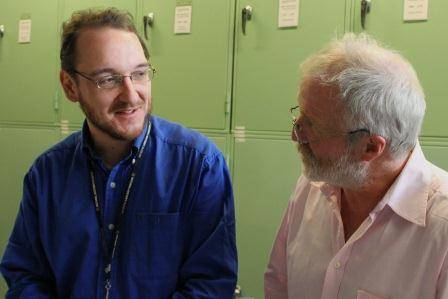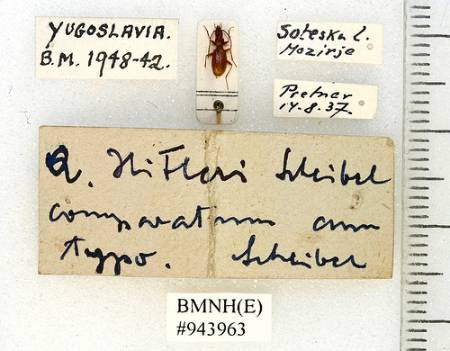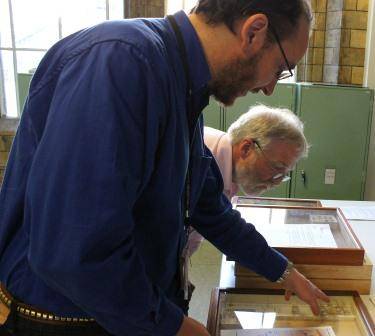As our beetle blog heads towards 50,000 views, it is fast becoming one of the most important interfaces between the Coleoptera Section and the world at large, but it is not the only public outreach that we do here on the section. As well as very regular Nature Live Events and Night Safaris at the Museum, we make occasional forays into radio and television, and one such example was on the 30th January when presenter Dr. George McGavin and BBC producer Andrea Rangecroft came to the Collections to record an interview on the 'Etymology of Entomology'
Max Barclay and George McGavin having a friendly chat about taxonomy, probably!
Even since the biblical instruction to Adam in the Garden of Eden to give 'a name to every creature' (leading to the oft-repeated quip that taxonomy, rather than anything else, is the 'oldest profession'), or perhaps more seriously since Linnaeus's Systema Naturae in 1758 which marks the start of formal Zoological Nomenclature, people have trying to name and classify the breathtaking biodiversity they see around them. There is considerable debate as to what is actually the largest group of organisms, with nematodes, some microbes, Hymenoptera (bees, ants and especially wasps) and Diptera (flies) all competing with beetles for the hypothetical species-richness crown, but of one thing we are certain: None of these groups has been so exhaustively and comprehensively named as the Coleoptera. Over 400,000 described species of beetles (about 20% of known biodiversity) shows an average rate, still undiminished, of 1000-2000 scientific names proposed each year since 1758 for beetles alone. It is perhaps not surprising, then, that a BBC team interested in the 'Etymology or Entomology' should have wanted to pay a visit to the beetle section..
Dr. George McGavin, the presenter of the show is an entomologist and zoologist and was once a student based at the Natural History Museum, so he is no stranger to the whiff of naphthalene and the ranks of cabinets and drawers that house one of the biggest slices of Earth's biodiversity to exist in one place anywhere in the world. His background of course meant that he knew many of us, and also pretty much what he wanted to see. In the radio show, he interviews a number of entomologists, (including me), and nomenclators in the UK and the US, such as the staff of the International Commission on Zoological Nomenclature (the august body based at the Natural History Museum, that regulates the naming of animals). To hear a sneak preview click on Radio 4!
The ranks of cabinets of the Coleoptera section holding over half of the World's known species
To provide a bit of background, Linnaeus's system, that is still used today, requires that each species has a unique scientific name, based (loosely) on Latin or Greek, and consisting of two parts, the genus name and the species name. These names are 'universal', i.e. used by scientists throughout the world and allow us to know exactly what species we are talking about; I have had many conversations with entomologists with whom I have no common language, that consist of pointing at specimens and saying scientific names, and it seems to work. Most of these names are serious, often descriptive, referring to colour (e.g. ruber, niger, albus, viridis), shape (spinosus, elongatus, angulatus), habitat (marinus, sylvaticus, montanus, campestris), size (maximus, minimus, pusillus, giganteus, nanus). Others refer to places of origin (germanicus, africanus, yorkensis, londonensis) or to people who the describer wanted to honour or commemorate. In the last case, the name is formed by adding a latin genitive '-i' or '-ii' for a man, '-ae' for a woman, or '-orum' for more than one person, to the end of the name in question (e.g. Eulipoa wallacei, Wallace's Megapode; Ischnura fountaineae, Margaret Fountaine's damselfly; Apion hookerorum, a weevil named after the Hooker brothers). Often the person honoured will be the collector, but sometimes it will be a figure from outside the world of science, a writer or entertainer or whatever, and in some cases a politician.
One of the beetles that George asked to see is one of the most controversial to be named after a famous person, a blind cave beetle forever cursed by its describer Oscar Scheibel with the name Anophthalmus hitleri. Scheibel presumably collected and named that species in 1936, because it was published in 1937, and it shows that one should never name anything after politicians, or at least wait until they are good and dead, since you never know what they are going to do.
Scheibel's unfortunately named beetle!
Other politically named beetles include Quentin Wheeler and Kelly Miller's slime mould beetles Agathidium bushi, Agathidium rumsfeldi and Agathidium cheneyi, named after US republican leaders. It is a popular misconception that in such cases the beetles are named as an insult, because beetles are considered somehow unpleasant (especially when they live in or feed on slime-moulds), but this is nonsense- we love our beetles too much! No professional coleopterist considers beetles to be unpleasant, and the names above are certainly honorific (in fact at least one of the scientists also named species after his wife).
On the subject of naming of insects after partners or prospective ones, George Willis Kirkaldy (1873-1910) deserves a mention. British born and based in Hawaii working for the sugar plantations, he studied the true bugs (Heteroptera) and discovered that the Greek suffix -chisme sounds, when spoken aloud, sufficiently like 'kiss me' that he prefixed a lot of genus names with words that sounded like the names of young ladies (or at least, the kinds of names that young ladies had in the early 20th century) - Dolichisme, Elachisme, Florichisme, Peggichisme, and Polychisme. Apparently Kirkaldy was criticised for frivolity at the Zoological Society of London, and one can imagine that a young man using the scientific nomenclature to crow about his romantic conquests might have raised a few eyebrows among the bewhiskered Edwardian patrons of that learned institution. A close contemporary of Kirkaldy, Horace Donisthorpe (1870-1951), whose collection is also at the NHM, apparently employed a similar strategy: many of his species and subspecies are named after young women of the day, some examples being primroseae, irenae, florenceae. The striking thing about these names is that none of them have stood the test of time- all have been shown by subsequent workers not to be distinct. One is drawn to the conclusion that Donisthorpe looked at something that the young ladies in question had collected, told them it was new, and went as far as formally naming it after them, but that his motives in doing so were perhaps not entirely scientific...
We also discussed the Russian entomologist Nikolay Nikolaevich Plavilstshikov (1892-1962), who (perhaps unsurprisingly) was drawn to complicated names and gave the world the longest scientific name, Brachyta interrogationis interrogationis var. nigrohumeralisscutellohumeroconjuncta Plavilstshikov, 1936 - a rather attractive, 1cm-long yellow and black longhorn beetle that lives in peonies in northern Eurasia. Plavilstshikov is also remembered for bringing a gun into work and shooting at his line-manager, and getting away with it, but that is another story...
With 400,000 beetles one can only imagine how many stories, told and untold, surround the choosing of their names. We have attempted on 'Etymology of Entomology' to tell just a few of the best of those stories, and our colleagues from other institutes and other countries have told others. We do hope you'll tune in at 10.30 on Saturday 9th March, and we'll provide live links as we get them
Max shows George some of the species talked about in the radio show
To find out a little more about the programme please read on...and tune in on Saturday 9th March at 10.30am
On Saturday 9th March at 10.30am on BBC Radio 4, popular culture meets science as zoologist Dr George McGavin delves into the strange, and often bizarre, names given to insects.
There are an estimated 8-10 million living insect species with new specimens being discovered almost daily. Entomologists are turning to ever more imaginative names, referencing everything from literary figures, celebrities and politicians to playground puns.
There are flies named Pieza kake (piece of cake) and Scaptia beyonceae after the singer; beetles with political connections - Anophthalmus hitleri, Agathidium bushi, Agathidium cheneyi and Agathidium rumsfeldi; even entomologists who name discoveries after romantic conquests. Unsurprisingly, names can prove controversial but, once set, are difficult to change.
"Taxonomy is the foundation stone of science…without a stable system of classification, science would be nothing but a jumble of uncorrelated observations."
George takes us into the complex and intriguing world of the taxonomist. From the 18th century father of modern taxonomy Carl Linnaeus, to the present day, he explains why naming the things that surround us is the foundation of all science.
George pieces together his story at Linnaeus’ original collection at The Linnaean Society, and at the capital’s Natural History Museum and London Zoo. He also reveals some insects named after him at the Oxford University Museum of Natural History.






